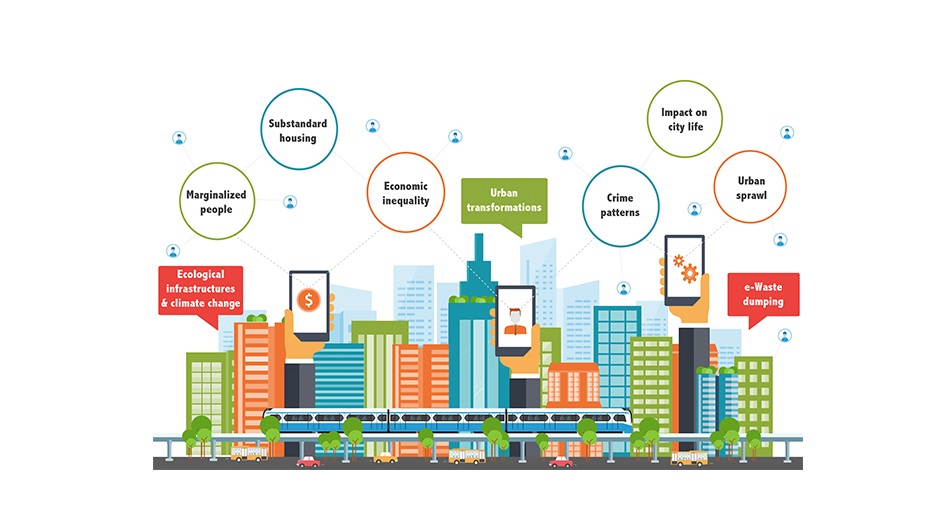Increasingly, cities have become bigger and more complex all over the world. According to the United Nations, in 2050, 66 percent of the world’s population will reside in urban areas, adding almost 2.5 billion people to the world’s fastest growing urban populations in Asia and Africa. As a city’s population expands, so do the amounts of natural resources used and the services needed to meet increased demands; in turn, inequalities become more evident.
How do we sustain rapid urban development? How do we serve larger populations? How do we predict crises and pressure points within cities? These are some of the big questions and problems that many cities, including Miami, are facing today.
From studying patterns of crime in a metropolis to the geographic mapping of urban areas, several researchers at the College are tackling these issues in their variety and complexity, and finding solutions to today’s urban challenges.
“People in the margins of society, those who use illegal drugs, or live in substandard housing, often escape the attention of participants in the larger society, especially if they live in the nooks and crannies of the big city. In the bubble of indifference or aversion that surrounds them, marginalized people may engage in behaviors that affect the larger society, or they may be suspected of having an effect. As a medical anthropologist who focuses on marginalized people, I attempt to sort out the facts from the myths about marginalized people in the big city.”
- J. Bryan Page, Ph.D., Director, International Studies, Professor, Anthropology
"To the surprise of many, Miami has become a global city, attracting financial flows, tourists, and migrants, not only from the Americas but the world over. The subject of my current research is two-fold: First, to understand how this happened. That is, how a minority-majority city managed to displace others as the focus of economic and social flows between Europe, the U.S., and the Americas; second, to assess how the growing diversity of Greater Miami's population and its relentlessly increasing economic inequality will bear on its future.”
- Alejandro Portes, Ph.D., Research Professor, Sociology
“Geography students receive training in how to map changes in the urban environment. In my remote sensing course, students learn how to transform the satellite images into digital land cover maps that display green space, built-up areas (roads, buildings, construction sites), and water bodies. Using repetitive imagery from high-resolution satellites, such as those in Google Earth, the students can measure the extent of major campus transformations associated with capital projects such as the BankUnited Center (completed in 2002), and the Donna E. Shalala Student Center (2013).”
- Douglas O. Fuller, Ph.D., Professor, Geography and Regional Studies
“My research examines the complexity of cities and networks in Accra, Ghana. I study e-waste dumping concentrated in slums that specialize in dismantling, reusing and repurposing, and extracting valuable fractions from waste, e.g. copper. Valuable fractions, in turn, get exported to China and India for reincorporation into new manufacturing processes.”
- Richard Grant, Ph.D., Director, Urban Studies, Professor, Regional Studies
“My research and teaching interests center on the history of urban planning and design, as well as their implications for present-day practice. My current projects include MAP: Miami Affordability Project, an online mapping tool to visualize the affordable housing landscape in Miami, as well as community development and historic preservation projects in Overtown, Allapattah, and Liberty City.”
- Robin Bachin, Ph.D., Associate Professor, History
“I completed a study of Miami’s Jewish community in 2015 for the Greater Miami Jewish Federation. One of the interesting findings was that the Jewish population of downtown Miami (from Brickell to Midtown) had tripled in the past decade. The increase is comprised mostly of young singles and young couples with preschool age children.”
- Ira Sheskin, Ph.D., Chair, Geography and Regional Studies
“Professor Elvira Maria Restrepo in Geography and I are collaborating on looking at patterns of crime in cities; she is the lead researcher. We look at where events occur, the territory of the gangs, and most importantly their composition and impact on other city life. We are interested in Miami (Professor Restrepo is a member of the Miami Task Force on gangs with local police), and also comparing the behavior to the huge sprawling cities in Latin America, e.g. Bogota in Colombia.”
- Neil Johnson, Ph.D., Professor, Physics
“In our Science Made Sensible (SMS) Program, 12 advanced undergraduates majoring in science serve as 'resident scientists' in Miami middle and high school classrooms. Each undergraduate develops hands-on activities with a teacher partner. SMS is a multi-generational model with six graduate students earning Ph.D.’s in the sciences, who in turn, mentor two undergraduates.”
- Michael Gaines, Ph.D., Professor, Biology
“My focus is on the ecological infrastructures that megacities need to improve their resilience to climate change. Usually, decision-makers think that technological solutions will fix everything, but that is not correct. Recent water scarcity in several megacities demonstrates that megacities need well-managed natural areas providing the essential ecosystem services (e.g., freshwater, protection against natural hazards, etc.).”
- José Maria Cardoso da Silva, Ph.D., Professor, Geography and Regional Studies
Other Notable A&S Professors Conducting Research in Urban Development:
Jafari S. Allen, Ph.D., Associate Professor, Anthropology
Donette Francis, Ph.D., Associate Professor, English
Tarell Alvin McCraney, Professor, Theatre Arts
Jonathan West, Ph.D., Professor, Director, Political Sciences
Dilip Sarkar, Ph.D., Associate Professor, Computer Science
Donald Spivey, Ph.D., Professor, History
March 29, 2016

